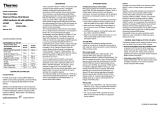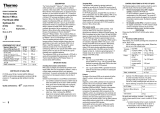Page is loading ...

PRODUCT INFORMATION
Thermo Scientific
Maxima First Strand cDNA Synthesis Kit for RT-qPCR
#K1641 for 50 rxns
Lot __
Expiry date __
Store at -20°C
v v
www.thermoscientific.com/onebio
CERTIFICATE OF ANALYSIS
Functionally tested in two-step RT-qPCR using different starting amounts (5 ng – 0.5 fg) of RNA
transcript in reverse transcription reactions followed by amplification with Thermo Scientific
Maxima SYBR Green/ROX qPCR Master Mix. Reaction efficiency is in the range of 90-110%,
slope is between -3.09 and -3.58 with a correlation coefficient of >0.99.
Quality authorized by: Jurgita Zilinskiene
Rev.7 h h

CONTENTS page
COMPONENTS OF THE KIT ................................................ 2
STORAGE ............................................................................. 2
DESCRIPTION ...................................................................... 2
IMPORTANT NOTES ............................................................ 3
PROTOCOL FOR RT-qPCR .................................................. 4
CONTROL REACTIONS ....................................................... 4
TROUBLESHOOTING ........................................................... 5
REFERENCES ...................................................................... 6
2
COMPONENTS OF THE KIT
Maxima First Strand cDNA Synthesis Kit
for RT-qPCR #K1641
50 rxns #K1642
200 rxns
Maxima Enzyme Mix 100 µL 400 µL
5X Reaction Mix 200 µL 800 µL
Water, nuclease-free 1.25 mL 4 1.25 mL
STORAGE
All kit components should be stored at -20°C.
DESCRIPTION
The Maxima® First Strand cDNA Synthesis Kit is a convenient system optimized for
cDNA synthesis in two step real time quantitative RT-PCR (RT-qPCR) applications. The
kit uses Maxima Reverse Transcriptase, an advanced enzyme derived by in vitro
evolution of M-MuLV RT. The enzyme features high thermostability, robustness and
increased cDNA synthesis rate compared to wild type M-MuLV RT. The Maxima First
Strand cDNA Synthesis Kit is capable of reproducible cDNA synthesis from a wide range
of starting total RNA amounts (1 pg - 5 µg) at elevated temperatures (50-65°C). The
synthesis reaction can be completed in 15-30 minutes.
Components of the Maxima First Strand cDNA Synthesis Kit are premixed to save time and
to reduce the possibility of pipeting errors. The contents of the kit include the Maxima
Enzyme Mix, 5X Reaction Mix and Water, nuclease-free.
Maxima Enzyme Mix contains Maxima Reverse Transcriptase and Thermo Scientific
RiboLock RNase Inhibitor. The recombinant RiboLock™ RNase Inhibitor effectively protects
RNA template from degradation by RNases A, B and C at temperatures up to 55°C.
5X Reaction Mix contains the remaining reaction components: reaction buffer, dNTPs,
oligo (dT)18 and random hexamer primers.
Water, nuclease-free is provided for reaction set-up and dilution of sample RNA. The
absence of endo-, exodeoxyribonucleases, ribonucleases and phosphatases has been
confirmed by appropriate quality tests.

3
IMPORTANT NOTES
Avoiding ribonuclease contamination
RNA purity and integrity is essential for synthesis of full-length cDNA. RNA can be
degraded by RNase A, which is a highly stable contaminant found in any laboratory
environment. All components of the kit have been rigorously tested to ensure that they
are RNase free. To prevent contamination, both the laboratory environment and all
prepared solutions must be free of RNases.
General recommendations to avoid RNase contamination:
Use certified nuclease-free labware or DEPC-treat all tubes and pipette tips to be
used in cDNA synthesis.
Wear gloves when handling RNA and all reagents, as skin is a common source of
RNases. Change gloves frequently.
Use RNase-free reagents, including high quality water (e.g., Water, nuclease-free,
#R0581).
Keep kit components tightly sealed when not in use. Keep all tubes tightly closed
during the reverse transcription reaction.
Template RNA
Total cellular RNA isolated by standard methods is suitable for use with the kit. Purified
RNA must be free of salts, metal ions, ethanol and phenol to avoid inhibiting the cDNA
synthesis reaction.
For RT-qPCR applications, template RNA must be free of DNA contamination. Prior to
cDNA synthesis, RNA can be treated with DNase I, RNase-free (#EN0521) to remove
residual DNA.
Always perform an RT-minus negative control reaction that includes all the components
for the RT reaction except for the Maxima Enzyme Mix.
RNA sample quality
Assess RNA integrity prior to cDNA synthesis. Total eukaryotic RNA can be analyzed by
agarose gel electrophoresis followed by ethidium bromide staining. Both 18S and 28S
rRNA appear as sharp bands after electrophoresis of total RNA. The 28S rRNA band
should be approximately twice as intense as the 18S rRNA. Any smearing of rRNA
bands is an indication of degraded mRNA. If this occurs, a new sample of total RNA
should be prepared. Alternatively, total RNA can be analyzed using a bioanalyzer (e.g.,
Agilent 2100) which provides quantitative information about the general state of the RNA
sample, the RNA integrity number (2). A reference gene/target gene 3’:5’ integrity assay
(3) can also be used to determine the integrity of the RNA sample.
Primers
The Maxima First Strand cDNA Synthesis Kit contains oligo(dT)18 and random hexamer
primers to prime synthesis of first strand cDNA. This primer mixture ensures high
sensitivity in low copy number transcript detection assays.
4
PROTOCOL FOR RT-qPCR
Please read the IMPORTANT NOTES section of the manual (page 2) before starting.
First Strand cDNA Synthesis
The first strand cDNA synthesis reaction can be performed as an individual reaction or
as a series of parallel reactions with different RNA templates. Therefore, the reaction
mixture can be prepared by combining reagents individually or a master mix containing
all of the components for the RT reaction except template RNA.
After thawing, mix and briefly centrifuge the components of the kit. Store on ice.
1. Add into a sterile, RNase-free tube on ice in the indicated order:
5X Reaction Mix 4 µL
Maxima Enzyme Mix 2 µL
Template RNA 1 pg - 5 µg
Water, nuclease-free to 20 µL
Total volume 20 µL
2 Mix gently and centrifuge.
3. Incubate for 10 min at 25°C followed by 15 min at 50°C.
Note. For RNA template amounts greater than 1 µg, prolong the reaction time to 30 min. For RNA
templates that are GC-rich or have a large amount of secondary structure, the reaction temperature can
be increased to 65°C.
4. Terminate the reaction by heating at 85°C for 5 min.
The product of the first strand cDNA synthesis can be used directly in qPCR or stored
at -20°C for up to one week. For longer storage, -70°C is recommended. Avoid
freeze/thaw cycles of cDNA.
qPCR
The product of the first strand cDNA synthesis reaction can be used directly in qPCR.
The volume of first strand cDNA synthesis reaction mixture should not comprise more
than 1/10 of the total PCR reaction volume. Normally, 2 µL of the RT mixture is used as
template for subsequent qPCR in a 25 µL total volume. The Maxima First Strand cDNA
Synthesis Kit is optimized for use with Maxima qPCR master mixes (#K0221, #K0231,
#K0241, K0251, #K0261).
CONTROL REACTIONS
Negative control reactions should be used to verify the results of the first strand cDNA
synthesis.
Reverse transcriptase minus (RT-) negative control is important in RT-qPCR
reactions to assess for genomic DNA contamination of the RNA sample. The
control RT- reaction should contain every reagent for the reverse transcription
reaction except for the Maxima Enzyme Mix.
No template control (NTC) is important to assess for reagent contamination. The
NTC reaction should contain all reagents for the reverse transcription reaction
except for the RNA template.

5
TROUBLESHOOTING
Problem Cause and Solution
No qPCR product
generated or
product appears late
in qPCR
Poor integrity of RNA template.
RNA purity and integrity is essential for synthesis and
quantification of cDNA. Always assess the integrity of RNA prior to
cDNA synthesis. (see page 2).
Follow general recommendations to avoid RNase contamination
(page 2) and discard low quality RNA.
Use freshly prepared RNA. Multiple freeze/thaw cycles of the RNA
sample as well as synthesized cDNA is not recommended.
Low template purity (inhibitors in RNA sample).
Trace amounts of agents used in RNA purification protocols may
remain in solution and inhibit first strand synthesis, e.g., SDS,
EDTA, guanidine salts, phosphate, pyrophosphate, polyamines,
spermidine. To remove trace contaminants, re-precipitate the RNA
with ethanol and wash the pellet with 75% ethanol.
Insufficient template quantity.
Increase the amount of RNA template in the first strand reaction to
the recommended level (see Protocol for RT-qPCR on p.3).
Following DNase I treatment, terminate the reaction by heat
inactivation of the enzyme in the presence of EDTA (to bind Mg2+).
RNA hydrolyzes during heating in the absence of a chelating
agent (1).
GC rich template.
If the RNA template is GC rich or is known to contain secondary
structures, the temperature of the reverse transcription reaction
can be increased up to 65°C.
Excess amount of cDNA in qPCR.
Decrease the amount of the cDNA synthesis reaction mixture
added to the qPCR reaction. The volume of the cDNA synthesis
reaction mixture should not exceed 10% of the final volume of the
qPCR reaction mixture.
RT-qPCR product in
RT-minus control
RNA template is contaminated with DNA.
The appearance of a PCR product in the negative control reaction
(RT-) indicates that the reaction is contaminated with DNA. To
avoid amplification of genomic DNA, design PCR primers on exon-
intron boundaries or perform DNase I digestion prior reverse
transcription.
6
REFERENCES
1. Wiame, I., et al., Irreversible heat inactivation of DNaseI without RNA degradation,
BioTechniques, 29, 252-256, 2000.
2. Fleige, S., Pfaffl, M.W., RNA integrity and the effect on the real-time qRT-PCR performance,
Mol. Aspects Med., 27, 126-139, 2006.
3. Nolan, T., et al., Quantification of mRNA using real-time RT-PCR, Nat. Protoc., 1, 1559-
1582, 2006.
Note:
This product or the use of this product is covered by US patent application US20110065606A1 and
corresponding counterparts. The purchase of this product includes a non-transferable license to use this
product for the purchaser's internal research. All other commercial uses of this product, including without
limitation product use for diagnostic purposes, resale of product in the original or any modified form or product
use in providing commercial services require a separate license. For further information on obtaining licenses
please contact [email protected]
PRODUCT USE LIMITATION
This product is developed, designed and sold exclusively for research purposes and in vitro use only. The
product was not tested for use in diagnostics or for drug development, nor is it suitable for administration to
humans or animals.
Please refer to www.thermoscientific.com/onebio for Material Safety Data Sheet of the product.
© 2012 Thermo Fisher Scientific Inc. All rights reserved. All trademarks are the property of Thermo Fisher
Scientific Inc. and its subsidiaries.
/











